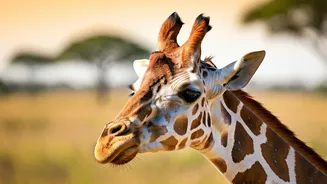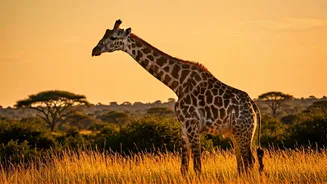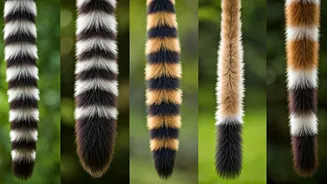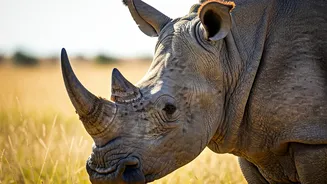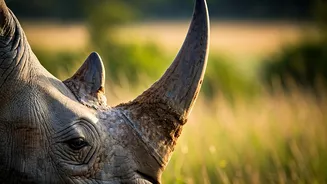Giraffe's Unique Spots
Each giraffe has a distinctive spot pattern, much like human fingerprints. These patterns are not only unique to each individual but also help in camouflage.
The shapes, sizes, and colors of the spots vary, allowing scientists and researchers to identify and study individual giraffes within a population. These patterns are essential for blending in with the savanna environment, helping them evade predators and sneak up on unsuspecting leaves and branches. These unique patterns are determined at birth, making them a consistent identifier throughout the animal's life. The intricate patterns also aid in regulating body heat. The dark spots absorb heat, while the lighter areas reflect it, helping them stay cool in hot climates. Researchers utilize these distinct patterns for population studies, tracking migration, and estimating the number of giraffes in a specific area.
Amazing Tongue Length
Giraffes possess incredibly long tongues, averaging around 18-20 inches (45-50 cm). This remarkable length allows them to expertly strip leaves from high branches, giving them an advantage in reaching food sources unavailable to other herbivores. The tongue is prehensile, meaning it can grasp and manipulate objects with remarkable dexterity. They use their tongues to grasp leaves and buds, carefully pulling them into their mouths. They also use their tongues to clean their faces and ears. The unique texture of their tongue is also worth noting; it has specialized papillae that help in grabbing onto rough surfaces and preventing thorns from causing injury. Furthermore, the giraffes' saliva is sticky, which helps in grasping and swallowing thorny branches and leaves. This adaptation plays a vital role in the giraffe's survival, letting it eat food inaccessible to most other animals.
Heart Powerhouse
Giraffes need a powerful heart to pump blood to their brain, given their height. Their heart can weigh up to 24 pounds (11 kg) and can generate twice the blood pressure of a human. This high pressure is crucial to supplying the brain with sufficient blood flow. Special adaptations in their circulatory system prevent blood from rushing to the brain when they lower their heads to drink. Valves in the jugular vein and a network of blood vessels regulate the blood flow. Upon standing up, their blood pressure dramatically increases to deliver blood to the brain. This efficient blood flow also supplies oxygen and nutrients. The heart's strength guarantees that the brain receives a constant supply of blood, supporting their complex cognitive functions. The unique design protects the giraffe from fainting when it lifts its head.
Neck Bone Details
A giraffe's neck, though remarkably long, consists of only seven vertebrae, which is the same number as humans. These vertebrae are, however, elongated, allowing for the extreme length of the neck. The neck plays a crucial role in foraging, allowing giraffes to reach high branches and access food. It is also used in combat. During sparring sessions, males use their necks to swing and hit each other, establishing dominance. The neck is also crucial for balance. These long necks require a highly specialized and strong set of muscles to support them. In addition to the seven vertebrae, the neck contains numerous ligaments and muscles that offer both flexibility and stability. The neck's design enables them to see above the savanna and scan the landscape for predators and any other possible danger.
Unique Horns Overview
Both male and female giraffes have horn-like structures called ossicones on their heads. Ossicones are covered with skin and hair, and they are formed from ossified cartilage. These structures are not true horns, which are made of keratin. Ossicones begin as cartilage and eventually ossify. In males, the ossicones are often thicker and more prominent. These ossicones are not just for show; they play a role in both display and fighting, especially during male-to-male combat. They use their heads to deliver powerful blows to each other. The position and size of the ossicones can also indicate the giraffe's age and health, allowing researchers to study the animals. Giraffes can also use their ossicones in communication and to express dominance within the herd. Their size and shape can vary from one giraffe to another.
Giraffe Sleep Needs
Giraffes sleep remarkably little, often only for around 30 minutes a day. This sleep can be taken in short bursts throughout the day or night. Due to their size and vulnerability to predators, giraffes must remain vigilant. They often sleep standing up, allowing them to quickly escape from any danger. Sometimes, they will lie down with their legs folded beneath them, but this position is more vulnerable, so it is usually only used in safe environments. Giraffes' sleep patterns are very flexible, allowing them to adapt to different situations. Giraffes' sleeping habits provide some unique challenges to researchers who want to study their sleep patterns. Their adaptations show the complex interplay between animal behavior and environmental pressures, leading to fascinating research and insights.
Dietary Habits of Giraffe
Giraffes are herbivores, and their diet primarily consists of leaves, buds, and fruits from trees. They are known to have a preference for acacia leaves. They spend a significant part of their day foraging. They carefully select their food. Their long necks give them an advantage in reaching these food sources. Their diet also includes various other plants. This dietary preference helps them avoid competition with other herbivores. Giraffes also need to drink water, and they can consume large amounts when available. The ability to extract moisture from their food can help them to survive for long periods without drinking. Their digestive system is adapted to process the tough, fibrous material they consume. They have four-chambered stomachs, similar to those of cows, enabling them to break down cellulose and absorb nutrients efficiently.
Social Structure Aspects
Giraffes live in loose, open groups called herds, but their social structures are complex. These groups typically consist of females and their young, with adult males often roaming separately or forming bachelor groups. Giraffes do not have strong social bonds; they may switch between groups frequently. Male giraffes use their necks to establish dominance, a practice called 'necking.' Males will fight each other, swinging their necks and heads. The goal is to assert their dominance. Dominant males often have access to females for mating. The social structure varies depending on factors such as food availability and habitat. Despite the lack of tight bonds, giraffes will often cooperate. They exhibit interesting social behaviors. These interactions play an important part in the giraffe's survival.
Conservation Challenges
Giraffe populations face various conservation challenges, including habitat loss, poaching, and climate change. Habitat destruction, mainly due to agriculture and human development, reduces the available space. Poaching for their meat, skin, and tails poses a significant threat. Climate change impacts their food supply. These threats vary regionally. Conservation efforts include habitat preservation, anti-poaching patrols, and community engagement. These efforts also involve scientific research. The goal of giraffe conservation is to maintain viable populations, ensuring these remarkable creatures continue to thrive. Raising awareness about the importance of protecting giraffes is crucial for their survival. Collaboration between conservation organizations, governments, and local communities can help ensure long-term preservation efforts.
